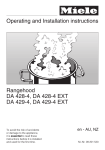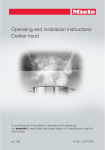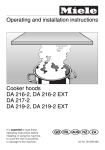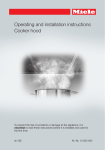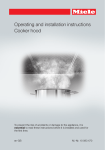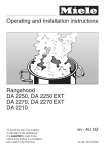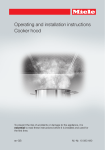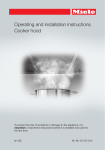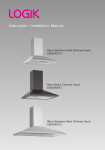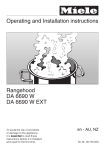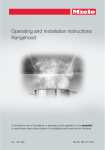Download Miele DA 2050
Transcript
Operating and Installation instructions Rangehood DA 2050 To avoid the risk of accidents or damage to the appliance, it is essential to read these instructions before it is installed and used for the first time. en - AU, NZ M.-Nr. 09 723 310 Contents Caring for the environment . . . . . . . . . . . . . . . . . . . . . . . . . . . . . . . . . . . . . . . . . . 3 Warning and Safety instructions . . . . . . . . . . . . . . . . . . . . . . . . . . . . . . . . . . . . . 4 Modes of operation . . . . . . . . . . . . . . . . . . . . . . . . . . . . . . . . . . . . . . . . . . . . . . . . 9 Guide to the appliance . . . . . . . . . . . . . . . . . . . . . . . . . . . . . . . . . . . . . . . . . . . . 10 Operation . . . . . . . . . . . . . . . . . . . . . . . . . . . . . . . . . . . . . . . . . . . . . . . . . . . . . . . 11 To switch the lighting on and off . . . . . . . . . . . . . . . . . . . . . . . . . . . . . . . . . . . . . . 11 To switch the fan on . . . . . . . . . . . . . . . . . . . . . . . . . . . . . . . . . . . . . . . . . . . . . . . . 11 To select a power level . . . . . . . . . . . . . . . . . . . . . . . . . . . . . . . . . . . . . . . . . . . . . 11 Intensive setting . . . . . . . . . . . . . . . . . . . . . . . . . . . . . . . . . . . . . . . . . . . . . . . . 11 Switching off . . . . . . . . . . . . . . . . . . . . . . . . . . . . . . . . . . . . . . . . . . . . . . . . . . . . . 11 Cleaning and care . . . . . . . . . . . . . . . . . . . . . . . . . . . . . . . . . . . . . . . . . . . . . . . . 12 Housing . . . . . . . . . . . . . . . . . . . . . . . . . . . . . . . . . . . . . . . . . . . . . . . . . . . . . . . . . 12 Grease filter . . . . . . . . . . . . . . . . . . . . . . . . . . . . . . . . . . . . . . . . . . . . . . . . . . . . . . 12 Fitting and replacing the charcoal filters . . . . . . . . . . . . . . . . . . . . . . . . . . . . . . . . 14 Changing a halogen lamp . . . . . . . . . . . . . . . . . . . . . . . . . . . . . . . . . . . . . . . . . . . 15 Appliance dimensions . . . . . . . . . . . . . . . . . . . . . . . . . . . . . . . . . . . . . . . . . . . . . 16 Safety distances between cooktop and rangehood (S) . . . . . . . . . . . . . . . . . . 16 Installation . . . . . . . . . . . . . . . . . . . . . . . . . . . . . . . . . . . . . . . . . . . . . . . . . . . . . . 18 Fitting the non-return flap. . . . . . . . . . . . . . . . . . . . . . . . . . . . . . . . . . . . . . . . . . . . 18 Building in . . . . . . . . . . . . . . . . . . . . . . . . . . . . . . . . . . . . . . . . . . . . . . . . . . . . . . . 18 Preparation for extraction . . . . . . . . . . . . . . . . . . . . . . . . . . . . . . . . . . . . . . . . . . . 19 Electrical connection . . . . . . . . . . . . . . . . . . . . . . . . . . . . . . . . . . . . . . . . . . . . . . . 20 Connection for air extraction . . . . . . . . . . . . . . . . . . . . . . . . . . . . . . . . . . . . . . . 21 Condensate trap . . . . . . . . . . . . . . . . . . . . . . . . . . . . . . . . . . . . . . . . . . . . . . . . . . 22 Silencer . . . . . . . . . . . . . . . . . . . . . . . . . . . . . . . . . . . . . . . . . . . . . . . . . . . . . . . . . 23 Electrical connection . . . . . . . . . . . . . . . . . . . . . . . . . . . . . . . . . . . . . . . . . . . . . . 24 After sales service . . . . . . . . . . . . . . . . . . . . . . . . . . . . . . . . . . . . . . . . . . . . . . . . 25 Technical data . . . . . . . . . . . . . . . . . . . . . . . . . . . . . . . . . . . . . . . . . . . . . . . . . . . 26 2 Caring for the environment Disposal of the packing material Disposal of your old appliance or machine The transport and protective packing has been selected from materials which are environmentally friendly for disposal and can normally be recycled. Electrical and electronic appliances / machines often contain materials which, if handled or disposed of incorrectly, could be potentially hazardous to human health and to the environment. They are, however, essential for the correct functioning of your appliance or machine. Therefore, please do not dispose of your old machine or appliance with your household waste. Ensure that any plastic wrappings, bags, etc. are disposed of safely and kept out of the reach of babies and young children. Danger of suffocation. Rather than just throwing these materials away, please ensure they are offered for recycling. Please dispose of it at your local community waste collection / recycling centre and ensure that it presents no danger to children while being stored for disposal. It should be unplugged or disconnected from the mains electricity supply by a competent person. The plug must be rendered useless and the cable cut off directly behind the appliance or the machine to prevent misuse. 3 Warning and Safety instructions This appliance complies with all relevant local and national safety requirements. Inappropriate use can, however, lead to personal injury and damage to property. To avoid the risk of accidents and damage to the appliance, please read these instructions carefully before using it for the first time. They contain important information on the safety, installation, use and maintenance of the appliance. Keep these instructions in a safe place and ensure that all users are familiar with the contents. Pass them on to any future owner of the appliance. Correct application ~ This rangehood is designed for domestic use and for use in similar environments by guests in hotel or motel rooms, bed & breakfasts and other typical living quarters. This does not include common/shared facilities or commercial facilities within hotels, motels or bed & breakfasts. ~ This appliance is not suitable for outdoor use. ~ This appliance is not intended for use by persons (including children) with reduced physical, sensory or mental capabilities, or lack of experience or knowledge, unless they are supervised whilst using it or have been been shown how to use it by a person responsible for their safety. ~ This appliance may only be used in mobile installations if a risk assessment of the installation has been carried out by a suitably qualified engineer. Safety with children ~ This appliance is only intended for use by adults who have read these instructions. ~ This appliance is not a toy! To avoid the risk of injury, keep children well away and do not allow them to play with it or to use the controls. They will not understand the potential dangers posed by it. They should be supervised whenever you are working in the kitchen. ~ Older children may use the ~ It must only be used as a domestic rangehood only when its operation has been clearly explained to them and they are able to use it safely, recognising the dangers of misuse. ~ Any other usage is not supported by the manufacturer and could be dangerous. Miele cannot be held liable for damage resulting from incorrect or improper use or operation of the appliance. ~ Please be aware that on rangehood appliance to extract vapours and remove odours from cooking. 4 with halogen lighting, the lamps will get very hot during use and remain hot for some time after switching off. To safeguard against burning, keep children well away from the lamps at all times. Warning and Safety instructions Technical safety ~ Before installation, check the rangehood for visible signs of damage. Under no circumstances should you use a damaged appliance. A damaged appliance is dangerous. ~ Before connecting the appliance to the mains supply, make sure that the voltage and frequency details given on the data plate correspond with the on-site electricity supply, otherwise the appliance could be damaged. Consult a qualified electrician if in any doubt. ~ The electrical safety of this appliance can only be guaranteed when continuity is complete between the appliance and an effective earthing system which complies with current local and national safety regulations. It is most important that this basic safety requirement is present and tested regularly and, where there is any doubt, the household wiring system should be inspected by a qualified electrician. The manufacturer cannot be held liable for the consequences of an inadequate earthing system (e.g. electric shock). ~ For safety reasons, this appliance may only be used when it has been fully installed. ~ Only open the housing as described in the instructions given in the installation sheet and in the Cleaning and care section of this booklet. Under no circumstances should any other parts of the housing be opened. Tampering with electrical connections or components and mechanical parts is highly dangerous to the user, and can cause operational faults. ~ Installation, maintenance and repairs may only be carried out by a Miele authorised person in accordance with current national and local safety regulations. Repairs and other work by unqualified persons could be dangerous. The manufacturer cannot be held liable for unauthorised work. ~ A damaged connection cable must only be replaced by an approved and suitably qualified technician. ~ Faulty components must only be replaced by genuine Miele original parts. The manufacturer can only guarantee the safety of the appliance when Miele replacement parts are used. ~ During installation, maintenance and repair work, the appliance must be disconnected from the mains electricity supply. It is only completely isolated from the electricity supply when: – it is switched off at the isolator, or – the screw-out fuse is removed (in countries where this is applicable), or – the mains fuse is disconnected, or – it is switched off at the wall socket and the plug withdrawn. 5 Warning and Safety instructions ~ Do not connect the appliance to the mains electricity supply by a multi-socket unit or an extension lead. These do not guarantee the required safety of the appliance (e.g. danger of overheating). Using at the same time as other heating appliances that depend on the air from the room Warning - danger of toxic fumes ~ This rangehood must not be installed and operated in mobile installations (e.g. on a ship). ~ In areas which may be subject to infestation by cockroaches or other vermin, pay particular attention to keeping the appliance and its surroundings in a clean condition at all times. Any damage which may be caused by cockroaches or other vermin will not be covered by the warranty. ~ Great care should be taken when using the rangehood at the same time and in the same room or area of the house as another heating appliance which depends on the air in the room. Such appliances include gas, oil, wood or coal-fired boilers and heaters, continuous flow or other water heaters, gas cooktops or ovens which draw air in from the room and duct exhaust gases out through a chimney or extraction ducting. When used in extraction mode, the appliance draws air in from the room in which it is installed and from neighbouring rooms. If there is insufficient air, an underpressure will occur. The heating appliance may be starved of oxygen, impairing combustion. Harmful gases could be drawn out of the chimney or extraction ducting back into the room, with potentially fatal consequences. 6 Warning and Safety instructions In order to ensure safe operation, and to prevent gases given off by the heating appliances from being drawn back into the room when the rangehood and the heater are in operation simultaneously, an underpressure of 0.04 mbar (4 pa) is the maximum permissible in the room. Correct use ~ Never use an open flame beneath the rangehood. To avoid the danger of fire, do not flambé or grill over an open flame. When switched on, the rangehood could draw flames into the filter. Fat particles drawn into the rangehood present a fire hazard. ~ When using the rangehood over a gas cooktop, ensure that any burners in use are always covered by a pan. Switch the cooking zone off when a pan is removed, even for a short time. Regulate the flame so that it does not burn up the sides of the pan. Do not allow the pans to overheat excessively (e.g. when using a wok). The rangehood can become damaged when exposed to excessive heat. Ventilation can be maintained by air inlets which must not be blocked, in windows, doors and outside wall vents, or by other technical measures, such as ensuring that the rangehood can only be switched on when the heating appliance is switched off or vice versa. A ventilation brick alone is not generally sufficient to ensure safe ventilation. ,The overall ventilation condition of the dwelling must be taken into account. If in any doubt, the advice of a competent builder or, for gas, a qualified gas fitter must be sought. ~ Always switch the rangehood on when a cooking zone is in use, otherwise condensation may collect in the hood, which could cause corrosion. ~ When cooking with oil or fat, chip pans and deep fat fryers etc., do not leave the pans unattended. Never leave an open grill unattended when grilling. Overheated oil and fat can ignite and could set the rangehood on fire. If in any doubt , the advice of a qualified builder, gas fitter or electrician must be sought. If the rangehood is being operated in recirculation mode, the above restrictions do not apply. 7 Warning and Safety instructions ~ Do not use the rangehood without the filters in place. This way you will avoid the risk of grease and dirt getting into the appliance and hindering its smooth operation. ~ Safety regulations prohibit the fitting of a rangehood over solid fuel stoves. ~ All ducting, pipework and fittings must be of non-flammable material. These can be obtained from Miele or from builders' merchants. ~ The filters should be regularly cleaned or changed as appropriate. Saturated filters are a fire hazard. See "Cleaning and care". ~ The appliance must not be ~ The rangehood can get very hot during cooking due to heat rising from the cooktop. Do not touch the housing or the grease filters until the rangehood has cooled down. ~ If exhaust air is to be extracted into ~ Do not use a steam-cleaner to clean this appliance. Steam could reach the electrical components and cause a short circuit. Accessories Correct installation ~ Refer to the cooktop manufacturer's instructions as to whether a rangehood may be operated above the cooktop. ~ The minimum safety distances between the top of the cooktop and the bottom of the rangehood given in the "Appliance dimensions" section of this booklet must be maintained, unless the cooktop manufacturer states that a greater safety distance is required. If more than one cooking appliance is fitted beneath the rangehood, and they have different minimum safety distances to the rangehood, select the greater distance. 8 connected to a chimney or vent flue which is in use. Neither should it be connected to ducting which ventilates rooms with fireplaces. a chimney or ventilation duct no longer used for other purposes, seek professional advice. ~ Only use genuine Miele spare parts and accessories with this appliance. If spare parts or accessories from other manufacturers are used, this will invalidate the warranty, and Miele cannot accept liability. The manufacturer cannot be held liable for damage caused by non-compliance with these Warning and Safety instructions. Modes of operation The rangehood works with . . . air extraction: . . . air recirculation: The air is drawn in, cleaned by the grease filter and then directed outside. (requires a conversion kit and charcoal filters: see "Technical Data") If the on-site ventilation system does not have a non-return flap, then the non-return flap supplied with the appliance must be fitted in the exhaust socket in the motor unit. The air is drawn in and cleaned first by the grease filter and then by two charcoal filters. The cleaned air is then recirculated back into the kitchen. Having a non-return flap fitted in the ducting ensures that air, once ducted to the outside, cannot get back into the room again. Before using the rangehood in recirculation mode, ensure that the charcoal filters are in place. See "Cleaning and care". The flap is closed when the rangehood is switched off. When the rangehood is switched on, the non-return flap opens for the cooking vapours to be blown directly outside. Please note, the performance of this rangehood hinges greatly on the installed ducting to vent the vapours. Poor choice of ducting results in poor rangehood performance. For ducting recommendations, please refer to the relevant section in these operating instructions or contact a specialised installer. 9 Guide to the appliance a Lighting switch b Fan switch c Cooktop lighting d Charcoal filters Special accessory for recirculation mode e Grease filter 10 Operation To switch the lighting on and off The cooktop lighting a can be switched on and off independently of the fan. "0" - lighting off "1" - lighting on To switch the fan on ^ Turn switch b for the fan to "1". To select a power level You can select one of three power levels with switch b depending on how much the air needs to be filtered. Depending on the intensity of the cooking vapours, levels "1" and "2" are usually sufficient for normal cooking. Intensive setting For short periods of cooking food with intensive vapours and a strong aroma, e.g. when searing meat, you may wish to select the Intensive Setting "IS". After cooking If the air still needs to be cleared after cooking, we recommend letting the rangehood continue to run for a further ten minutes. Then switch the appliance off. Switching off ^ Turn switch b for the fan to "0". 11 Cleaning and care Before any cleaning or maintenance work is carried out, disconnect the rangehood from the mains supply. Ensure that: – it is switched off at the isolator, or – it is switched off at the wall socket and the plug removed, or – the mains fuse is withdrawn, or – the screw-out fuse is removed (in countries where this is applicable). A range of Miele branded cleaning and conditioning agents are available to order through your Miele Chartered Agent from Miele or via the internet on www.miele-shop.com. – abrasive cleaning agents, e.g. powder cleaners or cream cleaners and abrasive sponges, as well as pot scourers or sponges which have been used previously with abrasive cleaning agents. These will damage the surface material. Grease filter The re-usable metal grease filter in the appliance removes solid particles from the kitchen vapours (grease, dust, etc.) preventing soiling of the rangehood. Housing The surfaces and controls are susceptible to scratches and abrasions. Please observe the following cleaning instructions. ^ All external surfaces and controls can be cleaned using the Original Miele all purpose microfibre cloth, or with warm water and a small amount of washing-up liquid applied with a well wrung-out soft sponge or cloth. ^ Wipe the surfaces dry using a soft cloth. Do not use: – cleaning agents containing soda, acids, chlorides or solvents, 12 Clean the grease filter when it looks dirty, and avoid letting it become so dirty that the filtering effect is inefficient. To avoid a build-up of fat, it should be cleaned every 3-4 weeks on average, but sooner if necessary. ,An oversaturated filter is a fire hazard. ^ To take out the grease filter, release the locking clip on the filter, lower the filter 45°, unhook it at the back and remove it. Cleaning and care To avoid damaging the filter or the cooktop below, make sure you hold the filter securely at all times when handling it. Cleaning the grease filter by hand ^ Clean the filter with a soft nylon brush in a mild solution of hot water and a small amount of washing-up liquid. Do not use undiluted washing-up liquid. ^ When removing the filter for cleaning, also clean off any residues of oil or fat from the now accessible housing to prevent the risk of these catching fire. When putting the grease filter back in position, ensure that the locking clip is visible facing down towards the cooktop. Do not use: – cleaning agents containing descaling agents, – powder cleaners, cream cleaners or abrasive all-purpose cleaning agents, – oven sprays. Cleaning the grease filter in the dishwasher ^ If the grease filter is inadvertently replaced upside down, insert a small screwdriver blade into the slit to disengage the clip. ^ Place the filters as upright as possible in the lower basket. Ensure the spray arm is not obstructed. ^ Do not wash at more than 65 °C. If a Miele dishwasher is being used, select the Sensor wash programme. ^ Use a mild dishwasher detergent. Depending on the cleaning agent used, cleaning the filters in a dishwasher can cause permanent discolouration to the surface. However, this will not affect the functioning of the filters in any way. ^ After cleaning, leave the filter to dry for a while on an absorbent surface before putting it back in place. 13 Cleaning and care Fitting and replacing the charcoal filters If the rangehood is connected for recirculation, two charcoal filters must be inserted in addition to the grease filter. They are designed to absorb cooking odours and are fitted in the canopy above the grease filter. New filters can be purchased from your Miele Chartered Agent or from Miele. See back cover for contact details, and "Technical data" for the model number of the filter. ^ Before fitting or replacing the active charcoal filters, the grease filter must first be taken out, (see previous section for instructions on how to do this). ^ Unwrap the charcoal filters. ^ Insert the charcoal filters into the canopy. ^ Replace the grease filter. 14 Replace the charcoal filters when they no longer absorb kitchen odours effectively. They should, however, be replaced at least every 6 months. Used charcoal filters can be disposed of with the normal household waste. Cleaning and care Changing a halogen lamp Before any cleaning or maintenance work is carried out, disconnect the rangehood from the mains supply. Ensure that: – it is switched off at the isolator, or – it is switched off at the wall socket and the plug removed, or – the mains fuse is withdrawn, or – the screw-out fuse is removed (in countries where this is applicable). ^ Remove the grease filter. ^ Remove the charcoal filters if the rangehood is being used in recirculation mode. ,Exercise caution when changing halogen lamps. They get very hot during use, and remain hot for some time after being switched off. Do not touch the surface directly when changing a lamp, as grease particles from your fingers will adhere to the surface and damage it. Please follow the manufacturer's instructions. ^ Push down the lighting unit slightly via the opening in the safety panel. ^ The halogen lamp is now accessible and should be unscrewed anti-clockwise. ^ Replace it with a new halogen lamp (specification: GU/GZ 10, 230 V, 50 W). Screw the lamp into the socket and push it upwards. Please follow the manufacturer's instructions. We recommend only using lamps of the same specification and also made by the same manufacturer as the ones being replaced. ^ Replace the grease filter and, if being used in recirculation mode, the charcoal filters. 15 Appliance dimensions Safety distances between cooktop and rangehood (S) The minimum safety distances between the top of a cooktop and the bottom of the rangehood are as follows, unless a greater distance is specified by the manufacturer of your cooking appliance: *Cut-out dimensions A depth T of at least 25 mm must be provided at the back of the building-in niche. Cooking appliance Distance S Electric cooktop 600 mm Open electric grill 650 mm Deep fat fryer (electric) 650 mm Multi-burner gas cooktop with maximum 45.4 MJ/h total output, with no burner having a greater output than 16.2 MJ/h. 650 mm Multi-burner gas cooktop with total output greater than 45.4 MJ/h, or a gas cooktop including a single burner with an output greater than 16.2 MJ/h. 760 mm Single gas cooktop with a maximum output of 21.6 MJ/h 650 mm Single gas cooktop with a maximum output greater than 21.6 MJ/h 760 mm See "Warning and Safety" instructions for further information. 16 Appliance dimensions – When deciding on the safety distance between the cooktop and rangehood, please note that a distance of 650 mm above electric cooktops may be preferable to give more working space under the hood. – Account should also be taken of the height of the person who will be using the hood most often. The person should have sufficient space to work comfortably at the cooktop, and also be able to reach the rangehood controls with ease. – Please be aware that if positioned too high, extraction will be inefficient. 17 Installation Fitting the non-return flap (Air extraction mode only) ^ Place the appliance in the cut-out from below and align it. ^ If a non-return flap is not present in the venting system, the non-return flap supplied must be fitted onto the exhaust socket in the motor unit. The flaps must open upwards. ^ Secure the rangehood by the frame using 3.5 x 16 mm screws. Building in The rangehood is intended to be built into wall units, rangehood housing units, and above breakfast bars or island areas. Check prior to installation that the top of the appliance will be accessible after installation. If this is not the case, install the exhaust ducting and prepare the electrical connection before installation. 18 ^ Before using the appliance for the first time, take the grease filters out and remove the protective foil from the filter frame. Then replace the grease filters. Installation Preparation for extraction Recirculation ^ When using C 150 mm ducting, secure the exhaust connection supplied to exhaust ducting with hose clips. ^ Place the exhaust ducting on the fan connection for the rangehood. ^ See "Connection for air extraction" for further instructions on fitting the ducting. If site conditions are not suitable for the rangehood to be used with air extraction, the appliance must be set up for recirculation. For this, conversion kit DUU 151 (available from Miele Chartered Agent or Miele) is required. You will also need two charcoal filters (see “Technical data”). 19 Installation ^ Dismantle the non-return flap. ^ Take the on-site conditions into account when fitting the conversion kit. When fitting the exhaust grille, make sure that the slats in the grille point towards the centre of the room and not directly towards a wall or the ceiling. ^ Fit the charcoal filters. Electrical connection Before connecting the appliance, read the safety notes in "Warning and Safety instructions" and "Electrical connection". 20 Connection for air extraction Important: To avoid the danger of toxic fumes, please observe the Warning and Safety instructions. This is especially crucial when using the rangehood at the same time as another heating appliance which relies on air from the same room. The rangehood should be installed according to local and national building regulations. Seek approval from the building inspector where necessary. – The exhaust ducting should not be kinked or compressed. – Ensure that all connections are strong and airtight. – Where ducting is horizontal, it must be laid to slope away at at least 1 cm per metre. This is to ensure that condensate cannot drain back into the rangehood. – Only use smooth pipes or flexible hoses made from non-flammable materials for the extraction ducting. To achieve the greatest possible air extraction with the lowest noise level, please note the following: – To ensure efficient air extraction, the diameter of the exhaust ducting should not be less than 150 mm. – If flat ducting is being used, the cross-sectional area must not be smaller than the cross-sectional area of the exhaust connection. If exhaust ducting with a diameter of less than 150 mm, or if flat ducting is used, the noise level of the rangehood will increase and extraction will be less efficient. – All ducting, pipework and fittings must be of non-flammable materials. – If the exhaust air is to be ducted into the open air, the installation of a telescopic wall vent or roof vent (available as an optional accessory) is recommended. – If the exhaust air is to be ducted into a vent flue, the ducting must be directed in the flow direction of the flue. Important: If the exhaust ducting is to run through rooms, ceiling space etc. where there may be great variations in temperature between the different areas, the problem of condensation will need to be addressed. The exhaust ducting will need to be suitably insulated. – The exhaust ducting should be as short and straight as possible. – Only use wide radius bends. 21 Connection for air extraction Condensate trap (optional accessory) For installations in areas where the exhaust ducting is exposed to cold temperatures, we recommend insulating the exhaust ducting and installing a condensate trap to collect and evaporate any condensate which may occur. Condensate traps are available for C 125 mm or C 150 mm ducting. When installing a condensate trap, ensure that it is positioned vertically and, if possible, directly above the exhaust connection. The arrow on the housing indicates the direction of air-flow. 22 Connection for air extraction Silencer (DASD 150, optional accessory) ...with air extraction: To achieve even further reductions in noise levels, a special silencer can be fitted in the ducting system. The silencer not only reduces noise from the fan, but also sounds from outside (e.g. traffic noise). For this reason, the silencer must be positioned as close as possible to where the ducting leaves the building a. ...in recirculation mode: The silencer needs to be positioned between the fan and the exhaust grille b. Ensure there is adequate space for fitting it. In all modes of operation, the most effective noise reductions are achieved if two silencers are fitted in the system. 23 Electrical connection All electrical work should be undertaken by a suitably qualified and competent person in strict accordance with current national and local safety regulations. Installation, repairs and other work by unqualified persons could be dangerous, for which the manufacturer cannot be held liable. Ensure power is not supplied to the appliance until after installation or repair work has been carried out. Do not connect the appliance to the mains electricity supply by an extension lead. These do not guarantee the required safety of the appliance. The connection data is given on the data plate. This is visible when the grease filters have been removed. Ensure that this data matches the household mains supply. Connection of this appliance should be made via a suitable isolator which complies with national and local safety regulations and the On-Off switch should be easily accessible after the appliance has been built in. 24 If the switch is not accessible after installation, an additional means of disconnection must be provided for all poles. For extra safety, it is advisable to install a suitable residual current device (RCD). Contact a qualified electrician for advice. Important This appliance is supplied for connection to an AC 230 V single phase 50 Hz supply. The wires in the mains lead are coloured in accordance with the following code: Green/yellow = earth Blue = neutral Brown = live WARNING: THIS APPLIANCE MUST BE EARTHED If the connection cable is damaged, it must be replaced by the manufacturer or similarly qualified persons to avoid a hazard. After sales service In the event of a fault which you cannot correct yourself, please contact: – Miele You will find the telephone number and address of Miele on the back cover of the manual. Please quote the model and serial number when contacting Miele. These are shown on the data plate which is visible when the grease filters are removed. Warranty The warranty for this appliance is 2 years. For further information, please refer to your warranty booklet. 25 Technical data Total rated load . . . . . . . . . . . . . . 185 W - Fan motor . . . . . . . . . . . . . . . . . . 85 W - Cooktop lighting . . . . . . . . . . 2 x 50 W Voltage . . . . . . . . . . . . . . . . . AC 230 V Frequency . . . . . . . . . . . . . . . . . 50 Hz Fuse rating . . . . . . . . . . . . . . . . . . . . 5 A Electrical cable length . . . . . . . . . 1.5 m Weight. . . . . . . . . . . . . . . . . . . . . . . 8 kg Fan performance Extraction power according to EN 61591 Extraction system C 150 mm: Level I . . . . . . . . . . . . . . . . . . . 150 m3/h Level II. . . . . . . . . . . . . . . . . . . 280 m3/h Level IV Intensive Setting . . . . 400 m3/h Recirculation with charcoal filters: Level I . . . . . . . . . . . . . . . . . . . 120 m3/h Level II. . . . . . . . . . . . . . . . . . . 230 m3/h Level IV Intensive Setting . . . . 360 m3/h Special accessories for recirculation mode: – Conversion kit DUU 151 – Miele charcoal filter pack DKF 15-1 (each pack contains 2 filters) 26 27 Alteration rights reserved / 3013 M.-Nr. 09 723 310 / 00




























